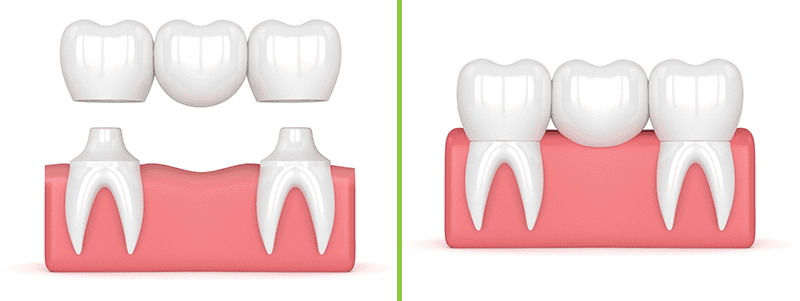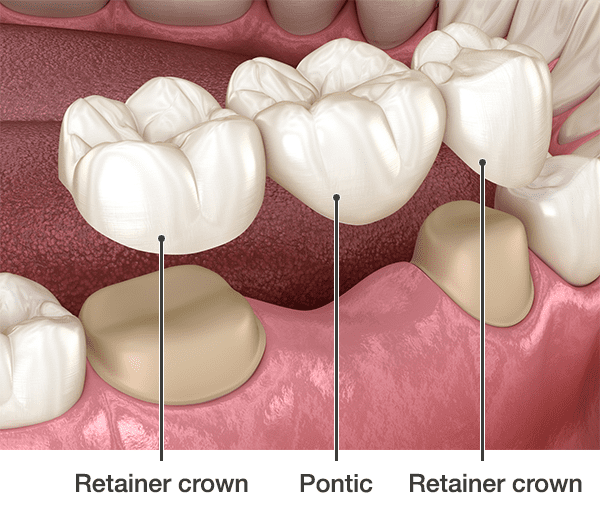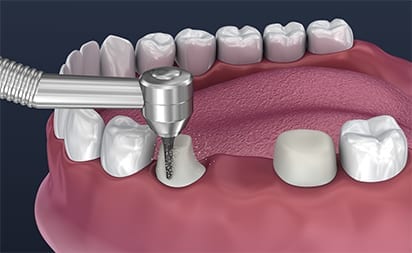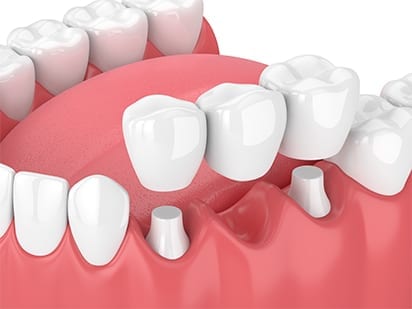Dental Bridges in East Gosford, Central Coast, NSW.
Our experienced team of dentists in East Gosford are committed to providing you with quality dental services on the Central Coast.
A dental bridge is a fixed replacement option for missing teeth. They will hide the gap of missing teeth and restore the appearance of your smile. Dental bridges look and function like natural teeth.
Call us today to discuss your dental needs, or click this button to book an appointment online now.
Our Offer: Free Cosmetic Smile Makeover Consultation
Free Cosmetic Smile Makeover Consultation
Dental crowns, bridges, veneers and major cosmetic restorations
Get procedural direction of care and cost estimates to see if this is the treatment option for you
Free
What is a dental bridge?
Bridges are a fixed solution to missing teeth.

A dental bridge will literally ‘bridge the gap’ created by one or more missing teeth, and restore the natural appearance of your smile.
A dental bridge is a permanent prosthetic appliance that consists of two or more dental crowns (artificial teeth) connected to each other to form one piece.
The dental crowns in the middle that will be filling the gap(s) of the missing teeth are called ‘pontics’. They look like solid, artificial teeth.
The dental crowns on each end of the bridge are called ‘retainer crowns’. They look like hollow, tooth-shaped ‘caps’ which are cemented onto the adjacent natural teeth to anchor the bridge in place.
The crowns that make up a dental bridge are made from ceramic (porcelain) to create a natural, translucent appearance that seamlessly matches the shape and colour of your existing teeth.

What is a dental crown?
A dental crown is a custom-made, permanent restoration. Basically, it is an artificial tooth.
Dental crowns look like hollow, tooth-shaped ‘caps’ which are cemented onto existing natural teeth (or onto dental implants).
When cemented into place, crowns completely cover the entire visible portion of the tooth that lies at and above the gum line.
A dental crown looks like this:

How do dental bridges work?
Dental bridges replace missing teeth by permanently joining onto the adjacent natural teeth on either side of the gap to secure the new artificial teeth in place.
When missing teeth are restored using a bridge, the adjacent natural teeth are firstly prepared (reduced in size, and reshaped) to allow adequate spacing for the crowns to be cemented on top.
The anchoring teeth on either side of a dental bridge are called “abutment teeth” or “retainers”, and the artificial teeth made to fill the gap are called “pontics”.
Once a bridge is cemented, it will look, function and feel just like natural teeth.
Benefits of dental bridges
Benefits of dental bridges include:
- Restore your smile.
- Look, feel and function like natural teeth.
- Restore your ability to chew and speak properly.
- Correct and re-distribute the normal biting forces, which are compromised by missing teeth.
- Prevents the shifting and movement of adjoining natural teeth (drifting into the gap).
- Reduces the risk of bone loss and maintains the structure and shape of your face.
- Fixed permanently in the mouth providing a solid and stable feeling (no movement as can happen with dentures).
- Don’t require removal for cleaning.
The consequences of leaving a gap
Leaving gaps in the dentition can result in a range of complications and consequences including:
- Bone loss (atrophy), which is the shrinkage and deterioration of the jawbone.
- Drifting movement of the adjacent or opposing teeth (adjacent teeth can ‘sink’ into the empty gap, and if the gap is in the lower jaw the opposing upper teeth can ‘drop’ downwards). This can then cause other teeth to move out of alignment.
- Loss of biting efficiency.
- Increased biting load on surrounding teeth as the natural force distribution is altered. This can lead to tooth mobility, cracking and increased wear of the biting surface on the remaining teeth and restorations.
- Increased frequency of restorations/fillings, due to increased wear on the biting surfaces.
- Aesthetic impact on smile.
Dental bridge procedure


A dental bridge is generally completed over two appointments:
Appointment 1
Firstly, the adjacent natural teeth on each side of the gap are prepared (reduced in size, and reshaped) to allow adequate spacing for the crowns to be cemented on top.
An impression will then be taken of the gap and the prepared adjacent teeth. This provides an exact mould for your dental bridge to be designed from.
Your impression will be sent to a dental laboratory where a qualified dental ceramist will manufacture your bridge out of ceramic (porcelain) material. Dental bridges are meticulously hand crafted, often using multiple layers of material in varying colour shades for a seamless, translucent and natural result.
In the meantime, you will be provided with a temporary dental bridge that is custom-made out of composite (plastic resin) material. The bridge will be fitted to the prepared natural teeth and will fill in the gap of the missing tooth/teeth. The temporary bridge will protect the natural teeth, as well as restore the aesthetic appearance of your smile, and will be matched to your natural tooth colour and shape.
The laboratory will generally take one week to create the dental bridge and return it to our surgery.
Appointment 2
At your second visit, the temporary bridge will be removed and the permanent bridge will be checked for fit and adjusted if necessary. It will then be permanently cemented onto your natural teeth.
Implant-supported bridges
Where there are no supporting natural teeth, an implant-supported bridge can be used.
An implant-supported bridge is similar to a regular bridge, but it is supported by dental implants on either end (instead of by natural teeth).
The dental bridge is still made up of pontics (in the middle) and retainer crowns (at each end), but the retainer crowns are secured to dental implants instead of natural teeth.
You can read more about implant-supported bridges here.

Dental bridge supported by natural teeth

Dental bridge supported by dental implants


